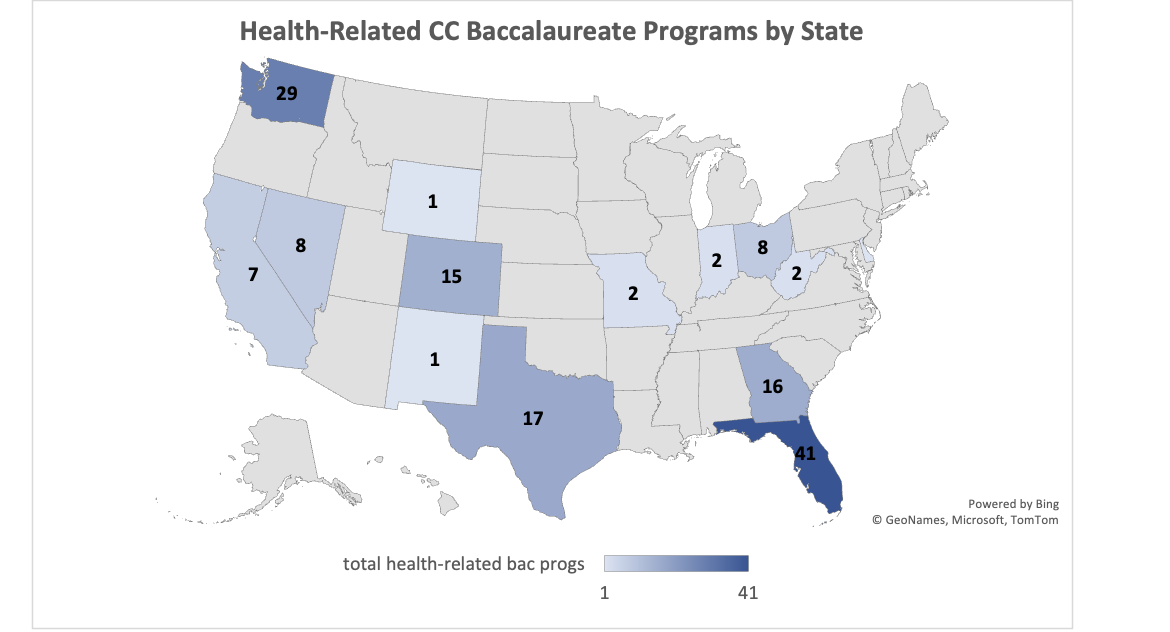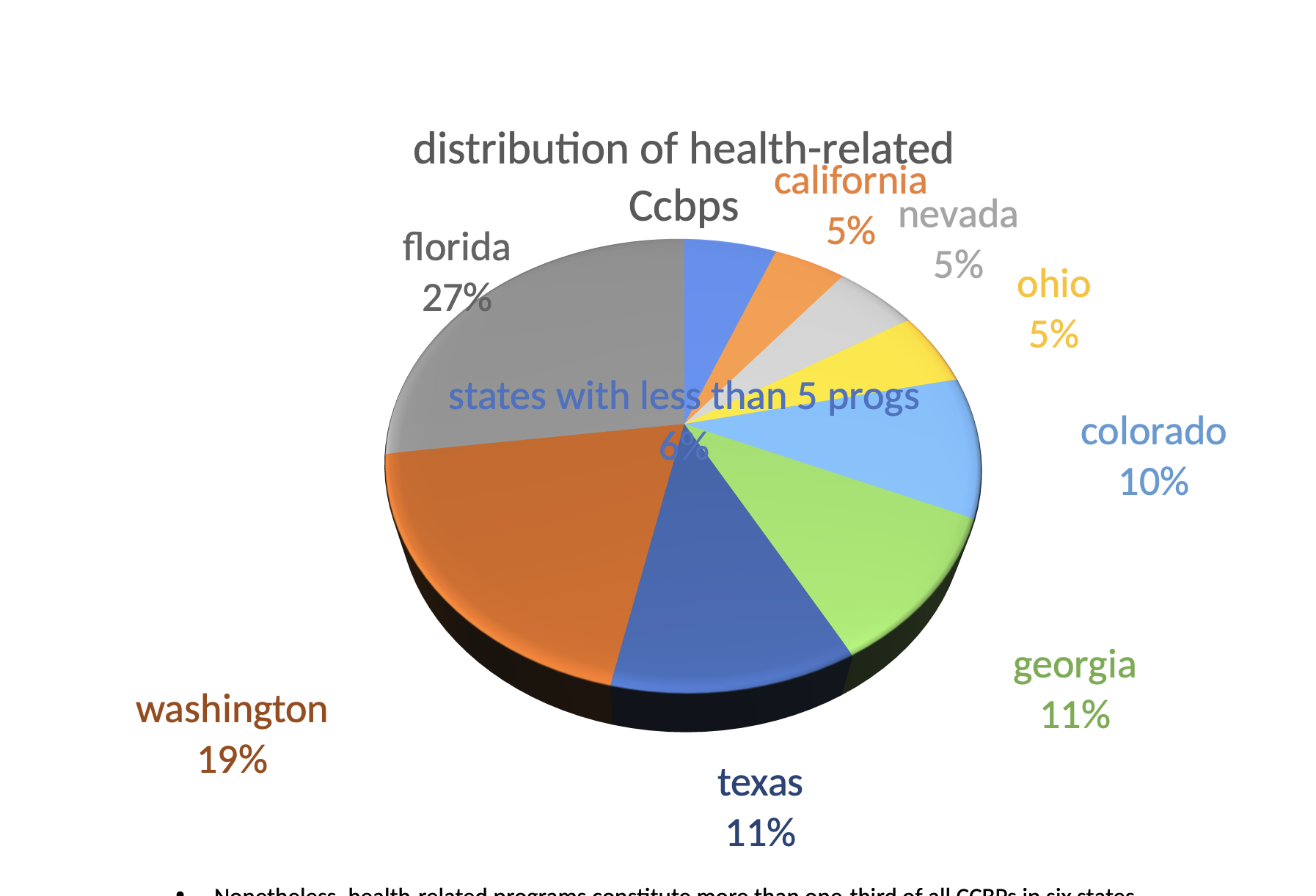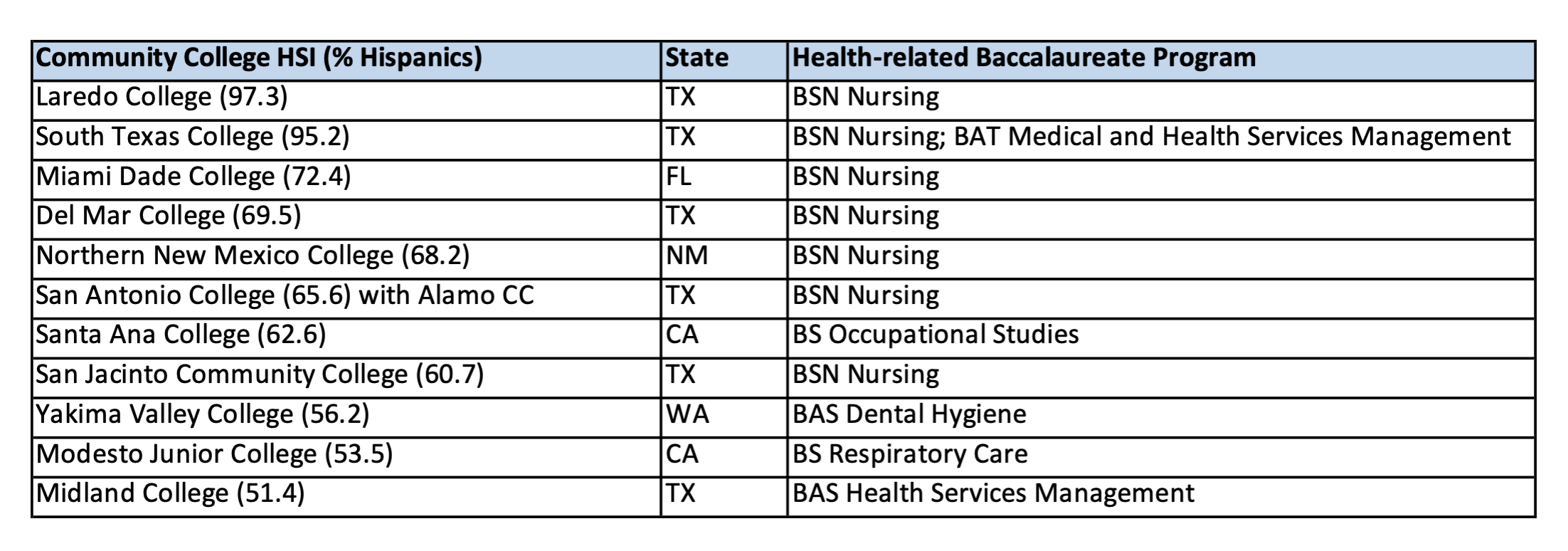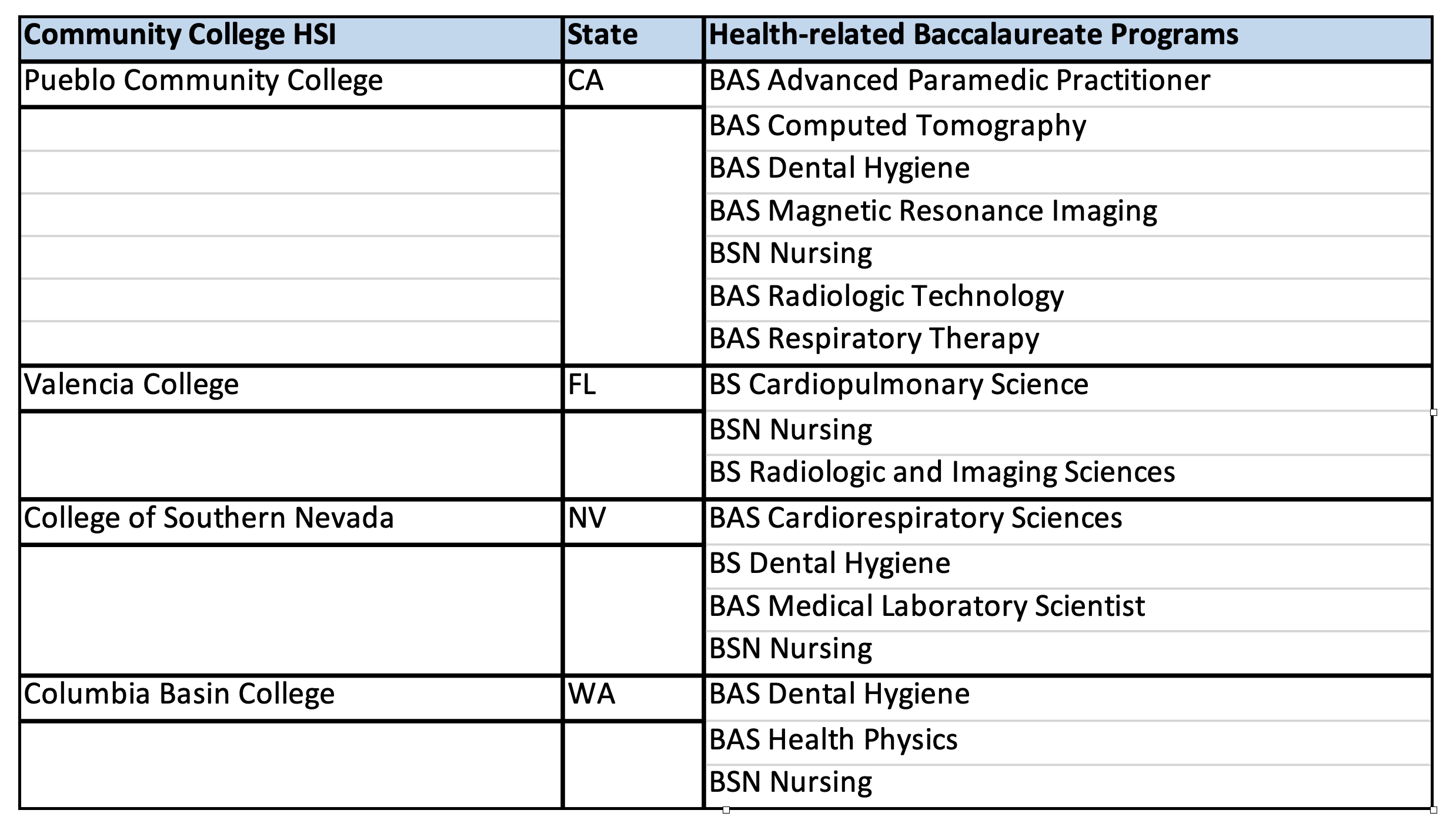Community colleges – as their name indicates – have always had the primary purpose of serving their communities by providing affordable, flexible 2-year associate degrees in fields of study that have direct, practical applications and that contribute to the local economy. Over the past few decades, the demand for students with more advanced, technical baccalaureate degrees has increased in certain economic sectors; at the same time, however, the supply of students has fallen short due to the higher cost of obtaining a degree at traditional 4-year colleges and universities, and the needs of an increasing number of students who work or are otherwise unable to commit to full-time programs. As a result, there has been a growing interest in providing 4-year baccalaureate degrees at community colleges, in applied fields that meet local workforce needs and are more accessible to nontraditional and underserved students.
In 1989, West Virginia was the first state to authorize a small number of bachelor’s degrees at 2-year institutions, followed by Vermont in 1993, New York in 1996, and Arkansas and Nevada in 1998. Today, half of all states – 25 - have authorized baccalaureate programs at community colleges, usually after formulating policies that address a number of issues raised by these new programs. Foremost among these is the concern that they expand the role of community colleges in ways that could be problematic: they could duplicate the offerings of 4-year colleges, they may not meet the same quality standards, and they might not be adequately funded and ultimately pass the cost on to students through higher tuition – thus defeating the purpose of more accessible programs for community college students.
At the same time, however, research about the functioning of these programs over the past 25 years has shown that they have conferred multiple benefits through partnerships and financial support from state agencies, universities, and employers. These benefits include reduced equity gaps, with greater enrollment among traditionally underserved students; filling local employers’ demand for employees in specific areas; providing graduates with high-skill, high-paying jobs while reducing their student debt; and technical training in new areas that address pressing issues such as climate change and cybersecurity. A California study also found that community college baccalaureate recipients were more likely to stay in their local communities, contributing to the state’s economy rather than moving away.
One of the key organizations that has been tracking the growth of these programs is the Community College Baccalaureate Association (CCBA), whose mission is to “provide support and resources to community colleges that build and sustain high-value, career-focused baccalaureate degrees.” According to the CCBA, 157 community colleges currently offer nearly 600 baccalaureate programs; on average, graduates from these programs are over 30 years old, 40% are non-white, and 57% are women. The CCBA database keeps track of the precise numbers and types of community college baccalaureate programs (CCBPs) in each state, providing a valuable resource for analysis of trends in this area.
Hispanic Outlook has conducted an original analysis of CCBA data in order to present in-depth profiles of CCBPs in different areas of study, adding a specific focus on Hispanic Serving Institutions (HSIs). As we know, community colleges are essential pathways to higher education for Hispanics/Latinos, a large proportion of whom attain their degrees at these institutions; it is thus imperative to understand the implications and opportunities offered by CCBPs. Given H.O.'s overall theme of health careers for this issue, we have begun with a profile of health-related CCBPs.
National Overview of Health-Related Community College Baccalaureate Programs
According to the CCBA database, there are currently 584 CCBPs across 25 states. Of these, our analysis indicates that 150 are health-related, defined as all programs with a Carnegie Classification of “Health Professions and Related Programs” (CIP codes beginning with 51). Thus, healthcare and nursing programs constitute 26% of all CCBPs.
• These health-related programs are present in 14 states, with the highest numbers in Florida and Washington, and the lowest in Delaware, New Mexico and Wyoming.

• Nearly half (46%) of all health-related CCBPs are found in just two states – Florida and Washington, and more than two-thirds (79%) are in only five states.

• Nonetheless, health-related programs constitute more than one-third of all CCBPs in six states. In Colorado and Texas, more than half of all CCBPs are health-related, and in Delaware and Missouri, which only have 1 and 2 CCBPs respectively, these are all health-related.

Health-related Community College Baccalaureate Programs at Hispanic Serving Institutions (HSIs)
• The CCBA reports that more than one-third of the total of 157 baccalaureate-conferring community colleges are HSIs. This proportion is also reflected among the 99 community colleges that have health-related baccalaureate programs – according to Hispanic Outlook’s analysis, 37 of these are HSIs, found in 7 of the 14 states that have these programs: California, Colorado, Florida, Nevada, New Mexico, Texas and Washington.
• Of these 37 HSIs, 11 have more than 50% Hispanic/Latino enrollment overall, which might indicate a high proportion of Hispanic/Latino students in health-related baccalaureate programs. However, this remains to be verified through specific analysis of each program.

• Ten of the HSIs that have health-related CCBPs offer two or more programs, and four offer three or more -

Types of Health-related Community College Baccalaureate Programs
• According to a detailed 2021 policy brief by the think-tank New America, interest in Bachelor of Science in Nursing – BSN – programs has increased notably, with states like Colorado and Texas scaling them up substantially in recent years, and others, like Ohio, passing recent legislation to allow community colleges to confer these degrees. This increased demand is due to the fact that healthcare sector employers are encouraging registered nurses to increase their credentials, while nurses themselves would like to receive higher salaries and be able to access managerial positions. In addition, there has been a need for a substantial increase in nurses overall, particularly after the pandemic.
Indeed, our analysis of CCBA data reveals that nearly half (47%) of all health-related CCBPs are in the field of Nursing. In the following table, programs were grouped according to CIP codes within the overall category of “Health Professions and Related Programs” (CIP code 51). These programs mostly confer Bachelor of Science (BS) and Bachelor of Applied Science (BAS) degrees, although they also confer some Bachelor of Applied Technology (BAT) degrees.

• Other fields that represent a large proportion of health-related CCBPs (with more than 10 programs each) are Health Administration, Management and Medical Informatics; Dental Hygiene; and Respiratory Care/ Cardiopulmonary Sciences, which together constitute one-third (34%) of all health-related CCBPs. New America’s policy brief describes how states use labor market demand data to make a case for baccalaureate degrees in new areas, including those within health care; this is coupled with the fact that credential requirements are increasing in several health fields. For example, the accreditation body for respiratory therapy programs is no longer accrediting new associate programs, only baccalaureate-level programs.

• Of the 37 HSIs that offer health-related CCBPs, the majority of programs are also in the field of nursing (26), followed by dental hygiene (8), respiratory care and cardiopulmonary sciences (7), and health administration, management and informatics (6). •
References
1. Mary Fulton, “Community Colleges Expanded Role into Awarding Bachelor’s Degrees,” April 2015 ECS Education Policy Analysis, at https://files.eric.ed.gov/fulltext/ED556034.pdf
2. Ibid. For a detailed analysis of state policy frameworks, see Ivy Love and Iris Palmer, “Community College Baccalaureate Programs: A State Framework,” New America Center on Education and Labor, at https://www.newamerica.org/education-policy/reports/community-college-baccalaureate-programs-state-policy-framework/
3. “Top Ten Reasons to Champion Community College Bachelor’s Degrees,” California Community Colleges, at https://www.cccco.edu/-/media/CCCCO-Website/docs/general/CCCReasonsToSupportBachelorsDegreeOnePager-31723.pdf; Araceli Aguilar et. Al., ‘Pioneering the Community College Baccalaureate in California’, August 2022 Research Brief, UC Davis Wheelhouse – Center for Community College Leadership and Research, at https://education.ucdavis.edu/sites/main/files/file-attachments/wheelhouse_research_brief_vol_7_no_2_final.pdf?1659636381.
4. Community College Baccalaureate Association Infographic, at https://www.accbd.org/wp-content/uploads/2023/04/CCBA-Infographic_4-25x11_42023.pdf
5. See https://www.accbd.org/state-inventory/
6. For consistency, a few health-related programs that are not classified under CIP code 51 were not included in this analysis - A BAS in Management and Supervision – Health Care Management, in Florida, and a BS in Organizational Leadership – Health Care Administration Program in Georgia, which are both classified under Business (52); and several degrees in Biomedicine which are classified under Biology.
7. The HSI status of each institution has been determined according to the 2020-21 list of HSIs provided by Excelencia in Education, at https://www.edexcelencia.org/Hispanic-Serving-Institutions-HSIs-2020-21
8. Ivy Love, Debra Bragg and Tim Harmon, “Mapping the Community College Baccalaureate: An Inventory of the Institutions and Programs Comprising the Current Landscape,” Nov. 9, 2021, New America Education Policy Brief, at https://www.newamerica.org/education-policy/briefs/mapping-the-community-college-baccalaureate/